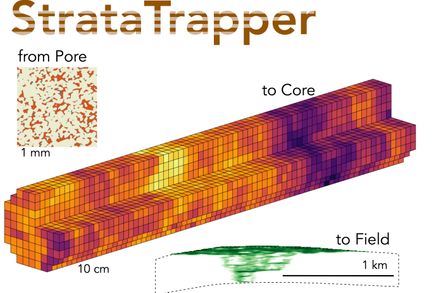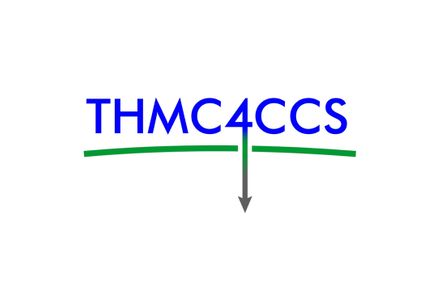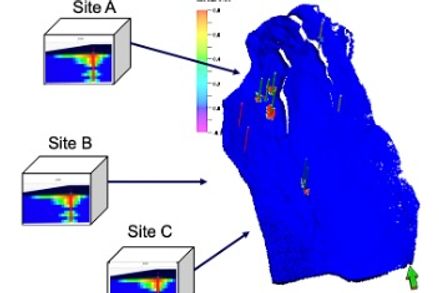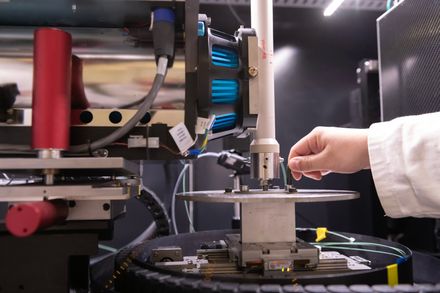We investigate the physics, chemistry, and techno-economics of CO2 storage underground
Our research includes exploring fundamental pore scale fluid dynamics, developing digital rocks analysis techniques, increasing the accuracy of field scale reservoir simulation, and evaluating the feasibility of scaling up CO2 storage to climate relevant scales.
Our Research Projects

StrataTrapper Advanced Modelling of CO2 Migration and Trapping

THMC4CCS: ThorougH experiMental and numerical investigation of Coupled processes for geologiC Carbon Storage
Results
- Showing results for:
- Reset all filters
Search results
-
Journal articleLin Q, Bijeljic B, Berg S, et al., 2019,
Minimal surfaces in porous media: Pore-scale imaging of multiphase flow in an altered-wettability Bentheimer sandstone
, Physical Review E, Vol: 99, Pages: 063105-1-063105-13, ISSN: 1539-3755High-resolution x-ray imaging was used in combination with differential pressure measurements to measurerelative permeability and capillary pressure simultaneously during a steady-state waterflood experiment on asample of Bentheimer sandstone 51.6 mm long and 6.1 mm in diameter. After prolonged contact with crude oil toalter the surface wettability, a refined oil and formation brine were injected through the sample at a fixed total flowrate but in a sequence of increasing brine fractional flows. When the pressure across the system stabilized, x-raytomographic images were taken. The images were used to compute saturation, interfacial area, curvature, andcontact angle. From this information relative permeability and capillary pressure were determined as functionsof saturation. We compare our results with a previously published experiment under water-wet conditions. Theoil relative permeability was lower than in the water-wet case, although a smaller residual oil saturation, ofapproximately 0.11, was obtained, since the oil remained connected in layers in the altered wettability rock.The capillary pressure was slightly negative and 10 times smaller in magnitude than for the water-wet rock,and approximately constant over a wide range of intermediate saturation. The oil-brine interfacial area wasalso largely constant in this saturation range. The measured static contact angles had an average of 80◦ with astandard deviation of 17◦. We observed that the oil-brine interfaces were not flat, as may be expected for a verylow mean curvature, but had two approximately equal, but opposite, curvatures in orthogonal directions. Theseinterfaces were approximately minimal surfaces, which implies well-connected phases. Saddle-shaped menisciswept through the pore space at a constant capillary pressure and with an almost fixed area, removing most ofthe oil.
-
Journal articleVeillard C, John C, Krevor S, et al., 2019,
Rock-buffered recrystallization of Marion Plateau dolomites at low temperature evidenced by clumped isotope thermometry and X-Ray diffraction analysis
, Geochimica et Cosmochimica Acta, Vol: 252, Pages: 190-212, ISSN: 0016-7037Much debate exists on the extent to which early dolomites recrystallize and preserve the signature of their primary diagenetic setting. Here, we combine clumped isotopes thermometry with X-ray diffraction and thin section petrography to study dolomite recrystallization under shallow burial (<1 km) conditions. We analysed 26 dolomite samples from two Miocene carbonate platforms on the Marion Plateau, NE Australia. Marion Plateau dolomites provide an ideal case study to examine the effects of recrystallization because of the relative simplicity of the geological setting, with simple subsidence, and several episodes of early dolomitization by normal Miocene sea water. Results show that Marion Plateau dolomites are very rich in calcium and their formation temperature inferred from clumped isotopes T(Δ47dol) ranges between 12 and 35°C. The apparent fluid composition (δ18Ow (app)) falls in the range of sea water composition, but a correlation between T(Δ47dol), δ18Odol, and δ18Ow (app) exists: the higher the crystallization temperature, the more negative the fluid composition is. T(Δ47dol) and δ18Ow (app) increase with depth, whereas δ18Odol and δ13Cdol tend to both decrease with depth. We interpret the negative correlation between T(Δ47dol) and δ18Ow (app) as evidence of shallow burial recrystallization via dissolution/re-precipitation. Modelling of the T(Δ47dol), δ18Odol, and δ18Ow (app) indicates that the recrystallization happened at very low water to rock ratio. Carbon isotopes are inherited from the dolomitization process, and not reset during recrystallization. This study shows that dolomite recrystallization has the potential to affect T(Δ47dol) at depths shallower than previously demonstrated. It emphasizes the fact that high calcium dolomites (and possibly aragonite and high Mg-calcite) can have a range of T(Δ47dol) before entering the solid-state reordering re
-
Journal articleLin Q, Bijeljic B, Krevor SC, et al., 2019,
A New Waterflood Initialization Protocol With Wettability Alteration for Pore-Scale Multiphase Flow Experiments
, Petrophysics – The SPWLA Journal of Formation Evaluation and Reservoir Description, Vol: 60, Pages: 264-272, ISSN: 1529-9074 -
Conference paperJackson SJ, Krevor S, 2019,
Characterization of hysteretic multiphase flow from the mm to m scale in heterogeneous rocks
, The 32nd International Symposium of the Society of Core Analysts, Publisher: EDP Sciences, ISSN: 2267-1242Incorporating mm-m scale capillary pressure heterogeneity into upscaled numerical models is key to the successful prediction of low flow potential plume migration and trapping at the field scale. Under such conditions, the upscaled, equivalent relative permeability incorporating capillary pressure heterogeneity is far from that derived conventionally at the viscous limit, dependent on the heterogeneity structure and flow rate, i.e. dependent on the capillary number. Recent work at the SCA 2017 symposium (SCA2017-022) demonstrated how equivalent functions can be obtained on heterogeneous rock cores from the subsurface under drainage conditions; going beyond traditional SCAL. Experimental observations using medical CT scanning can be combined with numerical modelling so that heterogeneous subsurface rock cores can be directly characterized and used to populate field scale reservoir models. In this work, we extend this characterization approach by incorporating imbibition cycles into the methodology. We use a Bunter sandstone core with several experimental CO 2 -Brine core flood datasets at different flow rates (2x drainage, 1x imbibition and 2x trapping) to demonstrate the characterization of hysteretic multiphase flow functions in water-wet rocks. We show that mm-m scale experimental saturations and equivalent, low flow potential relative permeabilities can be predicted during drainage and imbibition, along with trapping characteristics. Equivalent imbibition relative permeabilities appear as a function of capillary number, as in the drainage cases. We also find that the form of capillary pressure function during imbibition has a large impact on the trapping characteristics, with local heterogeneity trapping reduced (or removed), if the capillary pressure drops to zero, or below at the residual saturation.
-
Journal articleFranchini S, Charogiannis A, Markides CN, et al., 2019,
Calibration of astigmatic particle tracking velocimetry based on generalized Gaussian feature extraction
, Advances in Water Resources, Vol: 124, Pages: 1-8, ISSN: 0309-1708Flow and transport in porous media are driven by pore scale processes. Particle tracking in transparent porous media allows for the observation of these processes at the time scale of ms. We demonstrate an application of defocusing particle tracking using brightfield illumination and a CMOS camera sensor. The resulting images have relatively high noise levels. To address this challenge, we propose a new calibration for locating particles in the out-of-plane direction. The methodology relies on extracting features of particle images by fitting generalized Gaussian distributions to particle images. The resulting fitting parameters are then linked to the out-of-plane coordinates of particles using flexible machine learning tools. A workflow is presented which shows how to generate a training dataset of fitting parameters paired to known out-of-plane locations. Several regression models are tested on the resulting training dataset, of which a boosted regression tree ensemble produced the lowest cross-validation error. The efficiacy of the proposed methodology is then examined in a laminar channel flow in a large measurement volume of 2048, 1152 and 3000 μm in length, width and depth respectively. The size of the test domain reflects the representative elementary volume of many fluid flow phenomena in porous media. Such large measurement depths require the collection of images at different focal levels. We acquired images at 21 focal levels 150 μm apart from each other. The error in predicting the out-of-plane location in a single slice of 240 μm thickness was found to be 7 μm, while in-plane locations were determined with sub-pixel resolution (below 0.8 μm). The mean relative error in the velocity measurement was obtained by comparing the experimental results to an analytic model of the flow. The estimated displacement errors in the axial direction of the flow were 0.21 pixel and 0.22 pixel at flows rates of 1.0 mL/h and 2.5 mL/h, respectively. These resu
-
Journal articleLiyanage R, Cen J, Krevor S, et al., 2019,
Multidimensional observations of dissolution-driven convection in simple porous media using X-ray CT scanning
, Transport in Porous Media, Vol: 126, Pages: 355-378, ISSN: 0169-3913We present an experimental study of dissolution-driven convection in a three-dimensional porous medium formed from a dense random packing of glass beads. Measurements are conducted using the model fluid system MEG/water in the regime of Rayleigh numbers, Ra=2000−5000. X-ray computed tomography is applied to image the spatial and temporal evolution of the solute plume non-invasively. The tomograms are used to compute macroscopic quantities including the rate of dissolution and horizontally averaged concentration profiles, and enable the visualisation of the flow patterns that arise upon mixing at a spatial resolution of about (2×2×2)mm3. The latter highlights that under this Ra regime convection becomes truly three-dimensional with the emergence of characteristic patterns that closely resemble the dynamical flow structures produced by high-resolution numerical simulations reported in the literature. We observe that the mixing process evolves systematically through three stages, starting from pure diffusion, followed by convection-dominated and shutdown. A modified diffusion equation is applied to model the convective process with an onset time of convection that compares favourably with the literature data and an effective diffusion coefficient that is almost two orders of magnitude larger than the molecular diffusivity of the solute. The comparison of the experimental observations of convective mixing against their numerical counterparts of the purely diffusive scenario enables the estimation of a non-dimensional convective mass flux in terms of the Sherwood number, Sh=0.025Ra. We observe that the latter scales linearly with Ra, in agreement with both experimental and numerical studies on thermal convection over the same Ra regime.
-
Journal articleJackson S, Krevor S, 2019,
The Emergent Impacts of Small Scale Capillary Heterogeneity on Field Scale CO2 Flow and Trapping
-
Book chapterPini R, Krevor S, 2019,
Laboratory Studies to Understand the Controls on Flow and Transport for CO<sub>2</sub> Storage
, SCIENCE OF CARBON STORAGE IN DEEP SALINE FORMATIONS: PROCESS COUPLING ACROSS TIME AND SPATIAL SCALES, Editors: Newell, Ilgen, Publisher: ELSEVIER SCIENCE BV, Pages: 145-180, ISBN: 978-0-12-812752-0- Author Web Link
- Cite
- Citations: 9
-
Journal articleFranchini S, Charogiannis A, Markides C, et al., 2018,
Calibration of astigmatic particle tracking velocimetry based on generalized Gaussian feature extraction
-
Journal articleBudinis S, Krevor S, Mac Dowell N, et al., 2018,
An assessment of CCS costs, barriers and potential
, Energy Strategy Reviews, Vol: 22, Pages: 61-81, ISSN: 2211-467X© 2018 Elsevier Ltd Global decarbonisation scenarios include Carbon Capture and Storage (CCS) as a key technology to reduce carbon dioxide (CO2) emissions from the power and industrial sectors. However, few large scale CCS plants are operating worldwide. This mismatch between expectations and reality is caused by a series of barriers which are preventing this technology from being adopted more widely. The goal of this paper is to identify and review the barriers to CCS development, with a focus on recent cost estimates, and to assess the potential of CCS to enable access to fossil fuels without causing dangerous levels of climate change. The result of the review shows that no CCS barriers are exclusively technical, with CCS cost being the most significant hurdle in the short to medium term. In the long term, CCS is found to be very cost effective when compared with other mitigation options. Cost estimates exhibit a high range, which depends on process type, separation technology, CO2transport technique and storage site. CCS potential has been quantified by comparing the amount of fossil fuels that could be used globally with and without CCS. In modelled energy system transition pathways that limit global warming to less than 2 °C, scenarios without CCS result in 26% of fossil fuel reserves being consumed by 2050, against 37% being consumed when CCS is available. However, by 2100, the scenarios without CCS have only consumed slightly more fossil fuel reserves (33%), whereas scenarios with CCS available end up consuming 65% of reserves. It was also shown that the residual emissions from CCS facilities is the key factor limiting long term uptake, rather than cost. Overall, the results show that worldwide CCS adoption will be critical if fossil fuel reserves are to continue to be substantively accessed whilst still meeting climate targets.
This data is extracted from the Web of Science and reproduced under a licence from Thomson Reuters. You may not copy or re-distribute this data in whole or in part without the written consent of the Science business of Thomson Reuters.



